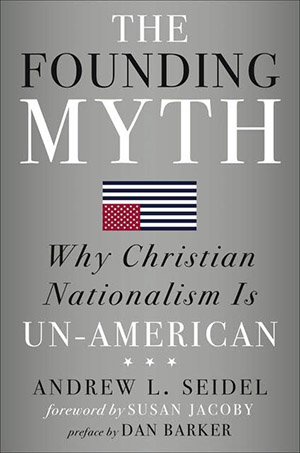From Alito Activism to Sloppy Lemons: 3 Takeaways From the Bladensburg Cross Oral Argument
Far from sending a troubling message, as Justice Alito contends, removing unconstitutional crosses maintained by the government on government land would send a clear and simple message: In the United States, the Constitution rules.

The Supreme Court’s first big state-church separation case in years had a distinct David and Goliath feel—impossible to miss while sitting in the courtroom for the oral argument.
On the side of the Constitution was a young attorney, one of only four women to speak in the court that day, representing the American Humanist Association and other plaintiffs challenging a 40-foot-tall Christian cross. On the side of that cross was arrayed a massive force: the solicitor general, bringing to bear the full weight of the United States government; a partner from Jones Day, the world’s fifth-largest law firm, representing the American Legion, which is the nation’s largest military veteran organization (Jones Day was pulled into the case by First Liberty Institute, a Christian nationalist outfit with a $10 million annual budget whose attorneys swaggered around the nation’s highest court as if they owned it); and a former acting solicitor general of the United States who is now a partner at Hogan Lovells (the world’s fourth-largest law firm), representing the Maryland-National Capital Park and Planning Commission.
Government, military, and Christian nationalism versus the simple principle woven into the fabric of our Constitution: the separation of state and church. It was a striking dichotomy.
Trying to prognosticate a case based on the oral argument is dangerous, and I won’t attempt it here. But there were three interesting takeaways.
Actually, Everyone Loves a Lemon (Test)
The most important lesson is that the central test the conservative bloc on the court and the Christian nationalist movement want to overturn is also the test they all relied on to make their arguments. As much as they wanted to, they could neither completely get away from the Lemon test nor propose anything better.
The Lemon test (from the 1971 Lemon v. Kurtzman decision) simply says a government action violates the separation of state and church if it (1) doesn’t have a secular purpose; or (2) has the primary effect of advancing or inhibiting religion; or (3) entangles the government with religion. Purpose, effect, entanglement. The first two prongs tend to be the focus and, despite the maligning of the Lemon test in the court, they came up repeatedly in the oral argument.
The government bodies that own the cross argued that the Lemon test is good law, but that it doesn’t apply because the cross is old. However, their proposed test focused on the first Lemon prong: “I think the test, Justice Ginsburg, would be whether there is an independent secular purpose.” Their attorney said this twice, very clearly. Though it was a bit unclear, it looked as though the former acting solicitor general tried to walk that back in an exchange with the chief justice. It was an odd moment, and not so much a Freudian slip as a Freudian admission.
Michael Carvin, the Jones Day partner whose argument was a train wreck for the American Legion and First Liberty, began by arguing that there is a simple test—his new streamlined, simple “Town of Greece Coercion Test”—before he walked it back and ended up with the test the Court currently uses, the Lemon test. As Justice Sonia Sotomayor said to sum up his argument, “[yours] is the endorsement test.” Which is to say, the Lemon test.
Carvin discussed “proselytizing purposes” and “non-proselytizing purpose[s].” He pivoted to Lemon again moments later: “If that’s the announced purpose and effect, of aligning ourselves with Christianity, then I would think it would sound much like proselytizing.” That’s the Lemon test. In case there was doubt, he did it yet again: “it is true, of course, that every test that this Court adopts needs to focus on context, purpose, and effect.”
He attacked the Lemon test and then proposed it under a different name, a poor choice. Justice Neil Gorsuch, who wants to overturn Lemon, grew frustrated with Carvin’s consistent retreat into the warm arms of the Lemon test: “You are taking us right back to the dog’s breakfast you’ve warned us against.” By the end of this argument, the First Liberty attorneys had lost all their swagger.
Even the solicitor general, who was more careful in his argument, admitted that a secular purpose—again, a part of Lemon—is critical, noting as he did the importance of “a secular meaning” and the “secular words” on the cross. Answering Justice Elena Kagan’s hypothetical about five different crosses, the solicitor general again pivoted to a Lemon inquiry, characterizing the hypothetical crosses as having a “non-war purpose” and stating that it would indeed be a constitutional problem “if a town just starts putting up naked, unadorned crosses without any clear secular reason.”
The test proposed was a Lemon by any other name; the American Legion in particular (via Carvin) maligned Lemon while simultaneously adopting it. When the justices asked about Lemon’s continued usefulness, the American Humanist Association seized on this point: “On the contrary, Your Honor, I think that Lemon is very useful … when you heard the arguments earlier today, they talked about context, they talked about purpose, they talked about effect.” She added that even Lemon was simply the case consolidating these principles—principles the court had adopted in many cases: “There was something like 14 cases pre-Lemon that were purpose and effect cases. Lemon just enshrined those…”
Apparently, a Cross Is Not Religious, but “In God We Trust” Is
While the solicitor general was more careful on Lemon, he had the brass to argue that a 40-foot-tall Latin cross modeled on the Calvary cross in the Bible was not a religious symbol. He even said it would be “permissible” to put this mammoth cross up, right now, because, according to the U.S. government, that Christian cross “has taken on a secular meaning associated with sacrifice or—or death or commemoration.” And then, in his next breath, when pushed by Kagan, he said, “I’m not going to dispute that, obviously, it’s the preeminent symbol of Christianity.”
The second striking—shocking, actually—aspect of this case is that the U.S. government argued the cross is not religious. Imagine if the government were declaring that the rosary wasn’t religious, or the bible wasn’t religious, or that a portrait of Jesus was not religious. It’s a 40-foot-tall Latin cross because, from the beginning, those who put it up wanted a “mammoth cross, a likeness of the Cross of Calvary, as described in the Bible.”
The Joint Baptist Committee’s brief did a nice job of showing how sacrilegious the government’s argument is to true Christians: Such a finding would be tantamount to the government “desacraliz[ing] the most sacred symbol of Christianity.” (The organization I represent, the Freedom From Religion Foundation, along with others filed a brief which also pointed out the cross does not represent the sacrifice of all soldiers, only Christians.)
It should go without saying that the cross-is-secular argument is hypocritical, too. But we actually got a bold statement of that hypocrisy from Carvin, the American Legion lawyer, who said: “‘In God we Trust’ certainly promotes religion, endorses religion, no question about it.”
That’s striking because courts have upheld that phrase on our currency and as our motto based upon a frustrating legal fiction—they’ve upheld the motto because, they argue, it’s no longer religious. “In God We Trust” has only been upheld by courts because phrases like it and “under God” in the Pledge of Allegiance “have lost through rote repetition any significant religious content.” Carvin’s admission is going to come back to haunt the Christian nationalist lobbying outfits like First Liberty who brought him on and helped prepare him for the case.
Upholding the First Amendment Is Not Hostile to Religion
One of the most alarming aspects of the argument provided the third lesson. Justice Samuel Alito espoused a line of argument that you typically only see on right wing Christian blogs, but not seriously considered by courts. Alito suggested that curing constitutional violations is hostile to religion and that that hostility violates the First Amendment. It’s logic through the looking glass: This violates the Constitution, but if we fix the violation, that fix will violate the Constitution. Alito asked, “What message does that send when people see that on—on TV, they see crosses all over the country being knocked down? … What—what message is that? … That may promote a particular worldview, but is that—is that consistent with the Establishment Clause?”
Alito’s argument that one potential solution—removing the cross—is hostile to religion necessarily assumes that the cross is religious, which in turn admits that it violates the separation of state and church. The argument is self-defeating. An equivalent might be arguing that striking down segregation to cure a violation of the Equal Protection Clause is hostile to white people—the argument admits the segregation the Constitution is meant to protect against.
But Alito’s questioning is troubling for another reason. Removing unconstitutional crosses maintained by the government on government land would send a clear and simple message: In the United States, the Constitution rules. The First Amendment requires that our government remains neutral on religion. The message would be that the Supreme Court of this nation upholds the Constitution. That is precisely the message this court should want to send, and Alito’s open antipathy to that message was deeply troubling.
I hope the court does the right thing and stands with the metaphorical David and the very material Constitution. Might does not make a constitutional violation right.


